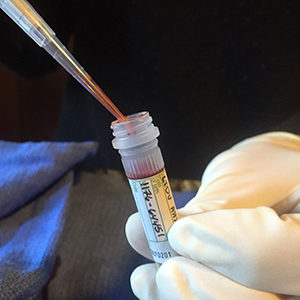BRI Studies: Contaminants Monitoring
With over 17 years of experience, BRI is a national leader in collecting, analyzing, and publishing data on the fate and transport of mercury in ecosystems. Other investigations include historical or legacy contaminants such as polychlorinated biphenyls (PCBs), perfluorocarbons (PFCs), polybrominated diphenyl ethers (PBDEs), and lead. Mercury samples are analyzed in BRI’s in-house laboratory.
Sample Collection

BRI specializes in the live capture and sampling of a broad range of taxa including invertebrates, fish, birds, and mammals. Sampling techniques are constantly improving and BRI biologists are at the forefront of developing novel methods for nonlethal capture.
The sampling of an individual can provide a wealth of information about contaminant exposure and health over the near-term (blood), mid-term (talon tips or webbing), and long-term (feathers or fur). For mammals such as river otter and mink, we can collect samples to determine an individual’s age.
For more information about BRI’s analytical capabilities using animal tissues, see our laboratory services.
Assessment of Polluted Areas

BRI has been involved with research projects that assess the effects of contaminants on different species from known polluted areas. Polluted areas identified by federal agencies undergo an ecological damage assessment process. BRI’s role has been to implement neutral, third party field studies for federal agencies and responsible parties at these polluted sites. BRI’s findings help determine which species are at most risk for contaminant exposure, as well as provide information needed to make informed conservation decisions for impacted wildlife and their habitats.
NRDA

Over the past 16 years, BRI has partnered with the U.S. Fish and Wildlife Service (USFWS) and the National Oceanic Atmospheric Administration (NOAA) to quantify environmental damages caused by contaminants (mostly oil and mercury pollution).
The process, known as Natural Resource Damage Assessment (NRDA), begins with an injury assessment. Then, a metric of animal-years-lost is quantified and assigned a monetary figure. Funds procured from the responsible party are used to restore damaged habitats and resources. The NRDA program, which originated with the Oil Pollution Act of 1990, compensates the public for the loss of or damage to natural resources.
Laboratory services provided by either:
- BRI’s Mercury Laboratory
- Affiliated accredited laboratories including, but not limited to:
- Boston University
- University of Connecticut
- Texas A&M
Photo Credits: Header Photo BRI Lab © Deb McKew; Blood Sample © Michelle March;



